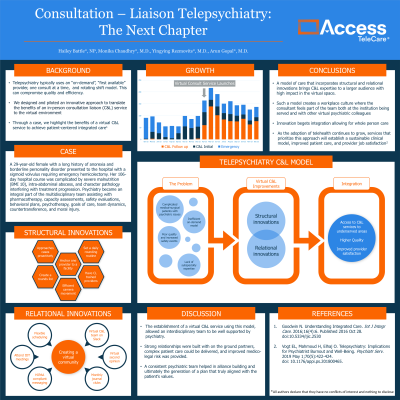Collaborative and Integrated Care
(055) Consultation-Liaison Telepsychiatry: The Next Chapter

.jpg)
Hailey Battle, NP
Staff Psychiatric Nurse Practitioner
Access Telecare
Colorado Springs, Colorado- YR
Yingying S. Rezmovits, MD
Staff Psychiatrist
Access telecare
Denver, Colorado 
Monika Chaudhry, MD, FAPA
Regional Medical Director and Staff Psychiatrist
Access Telecare
San Jose, California
Arun K. Gopal, MD
Director of the Consultation and Liaision Psychiatry Service
Access Telecare
Los Angeles, California
Presenting Author(s)
Co-Author(s)
Background: Many current telepsychiatry approaches to medical wards adopt an “on-demand”, “first available” provider, and rotating shift model which fragments care, leads to inefficiencies, and silos psychiatry. The next era of telepsychiatry must adopt innovations to achieve dissemination of subspecialty expertise. Through a case, we highlight the benefits of a virtual consultation and liaison (C&L) service specifically developed to mirror in person services, achieving patient-centered integrated care.1
Case: A 29-year-old female with a long history of anorexia and borderline personality disorder presented to the hospital with a sigmoid volvulus requiring emergency hemicolectomy. Her 106 day hospital course was complicated by severe malnutrition (BMI 10), intra-abdominal abscess, and character pathology interfering with treatment progression. Psychiatry became involved within three days of admission, assisting with pharmacotherapy, capacity assessments, safety evaluations, behavioral plans, psychotherapy, better defining patient values, and team dynamics. A multidisciplinary effort led to a discharge with tailored, holistic treatments.
Results:
Structural Innovations: Our virtual C&L service allowed for a consistent provider anchored to the facility. A rounding list allowed for proactive panel management, instead of reactive consult requests. Consistency allowed for improved diagnostics, alliance building, and reduction in behavioral outbursts. Close collaboration with champions on the ground resulted in efficient camera movement through a large hospital. Remote EMR access enabled real-time order entry and a comprehensive medical picture. Taken together, these innovations led to delivery of efficient and high value care.
Relational Innovations: Internally we created a virtual C&L community to draw on the expertise of our colleagues with a chat group. Cross privileging permitted second opinion evaluations. The C&L team's monthly journal clubs promoted relevant literature reviews, peer-to-peer discussions, and processing difficult dynamics. For our in-person clinical partners, having one primary consultant helped build relationships with stakeholders. Asynchronous HIPAA compliant messaging allowed close communication across multiple speciality teams (ethics, risk, nursing, hospitalist, etc). The consultant's attendance at interdisciplinary team meetings allowed more complex treatment planning while also serving to provide support to decrease caregiver burden.
Discussion: Establishing an effective virtual C&L service requires innovation. Creating meaningful connections required melding of structural and relational changes to enhance capacity to manage complex patients and connect remote and in-person teams. This provided for impactful co-management, a holistic approach to patient care, and expert guidance to a hospital that may not otherwise have had access to subspecialty services.
Conclusions: A model of care that brings C&L expertise to a larger audience is invaluable. Done correctly, it creates a workplace culture, where despite being virtual, the consultant feels part of the team both at the institution being served and with other virtual psychiatric colleagues2. Innovation begets integration allowing for whole person care. As the adoption of telehealth continues to grow, services that prioritize this will lead to sustainable business, public health, and clinical models while improving job satisfaction.
References:
Goodwin N. Understanding Integrated Care. Int J Integr Care. 2016;16(4):6. Published 2016 Oct 28. doi:10.5334/ijic.2530
Vogt EL, Mahmoud H, Elhaj O. Telepsychiatry: Implications for Psychiatrist Burnout and Well-Being. Psychiatr Serv. 2019 May 1;70(5):422-424. doi: 10.1176/appi.ps.201800465.
Presentation Eligibility: Not previously published or presented
Diversity, Equity, and Inclusion: Our virtual CL service covers multiple hospitals from coast to coast, serving areas that have limited access to psychiatry. These facilites are in underserved rural and urban areas with a high portion of marginalized and socio-economically disadvantaged patients. A virtual model that can increase the capacity to manage complex cases and bring high quality evidence based interventions to a larger population will help level set some disparities in treatment and outcomes. Such a service brings subspeciality care to parts of our healthcare system that would not have it given the dearth of psychiatric providers and especially consult liaison trained ones.

